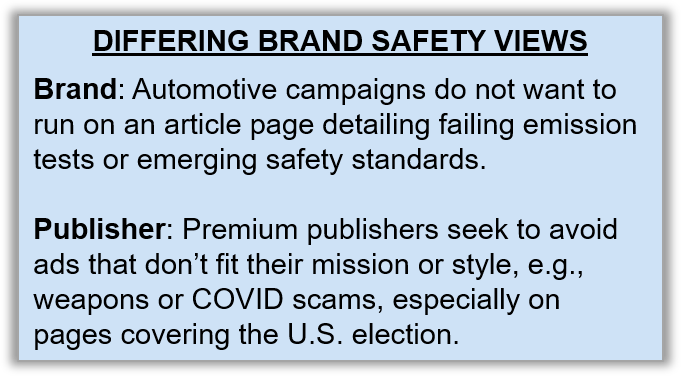Key Insights
- IAB Tech Lab Content Taxonomy 2.2 does not protect publishers from bad ads
- 2X increase in inflammatory ads since September; 5X growth in 2020
- Recommendations:
- Review complaints and creative content for potentially undesirable campaigns
- Ask upstream partners about their sensitive ad categories and how they manage them
- Measure and identify the source of unwanted creatives
To mitigate brand safety concerns associated with aggressive keyword blocking on publishers, the updated Content Taxonomy 2.2—released by the IAB Tech Lab and open for industry comments due November 27—introduces 11 sensitive categories and 4 risk levels. These new categories aim to provide more context to brands about a site’s content, and hopefully, unlock the estimated $4.1 billion in ad spend to the affected publisher sites. The goal of the taxonomy is to protect advertisers from bad content. What it does not do is protect publishers from bad ads.
Crux of the Brand Safety Problem
The taxonomy only addresses part of the brand safety challenge in digital advertising. While it will drive incremental revenue for some publishers, the taxonomy is not a straightforward process, nor will it help publishers control the quality of ads that run on their sites. This is a problem because bad ads can have a more critical and long-term impact on user engagement and the ensuing inventory degradation.
Brand safety has different meanings for digital advertising industry players. [Figure 1] Brands are concerned about the content on the pages where their ads run, aka “ad adjacency”. They want to maximize campaign effectiveness without offending their target market. Publishers are concerned about the creative that runs on their sites, aka “ad quality”.

These sensitive categories are a very subjective—yet important—topic across the digital ecosystem. While the risk levels in the Content Taxonomy are meant to address sensitivity, the broad-based nature of several categories will likely continue to block revenue to legitimate sites such as CraftBeer.com, HighTimes.com, MilitaryTimes.com and others.
In addition, large-scale partners like Google and Xandr have their own taxonomy for ad creative. This leads to mapping problems for publishers and their AdTech partners as they try to align the different taxonomies for ads with the larger Content Taxonomy.
Creative Taxonomy for Publishers
The events of 2020 have had a profound impact on publishers, with bad ads penetrating their sites that are considered inflammatory, adult/provocative, or spam and misleading content. [Figure 2]

As a result, publishers are on the receiving end of increasing complaints from their readers that lead to:
- Brand damage due to being associated with topics that inflame social, political and economic tensions, a serious concern for marketers, too
- Consumer harm from the Coronavirus-related scams that peaked in April, yet continue to defraud consumers
- Offensive content that does not respect religious or cultural standards in certain geographies, e.g., adult, alcohol, tobacco, gambling etc.
The industry needs a creative taxonomy to round out the brand safety issue and help protect publishers from ads that ruin their overall brand integrity.
Categorization – Publishers & AdTech
The vagaries and sensitivity of creative content categorization can be smoothed with expertise. Third-party categorization providers hone this expertise by reviewing millions of creative—The Media Trust reviews more than 5 million each month. You can’t rely on a brand to adequately self-declare their ads, specifically those potentially associated with content unwanted by publishers.
Publishers should demand that supply partners categorize the ad creative inventory that flows through their pipes to ensure it meets publisher requirements. This will help publishers further monetize their content, without damaging their relationships with their audiences and editorial teams.

